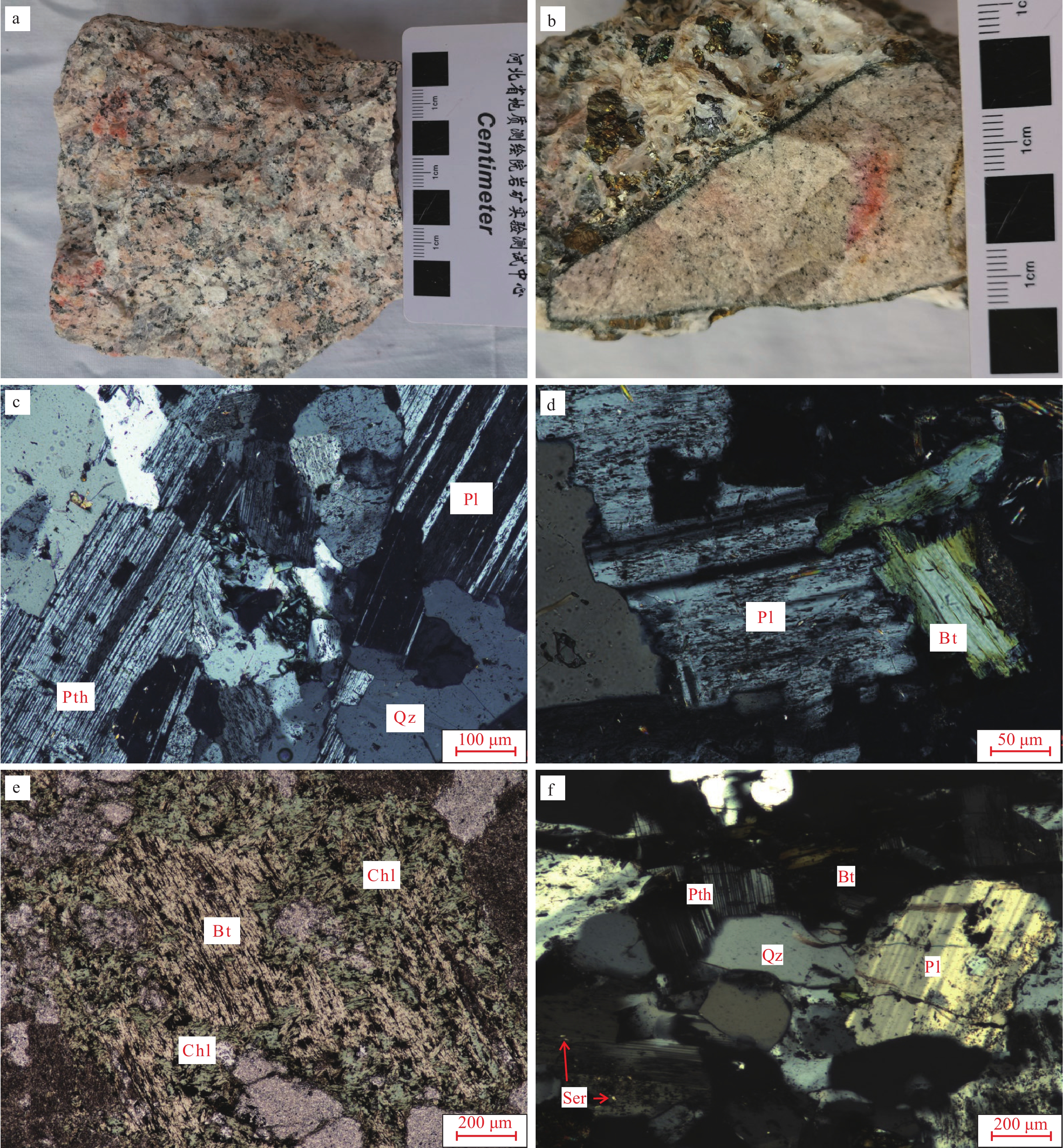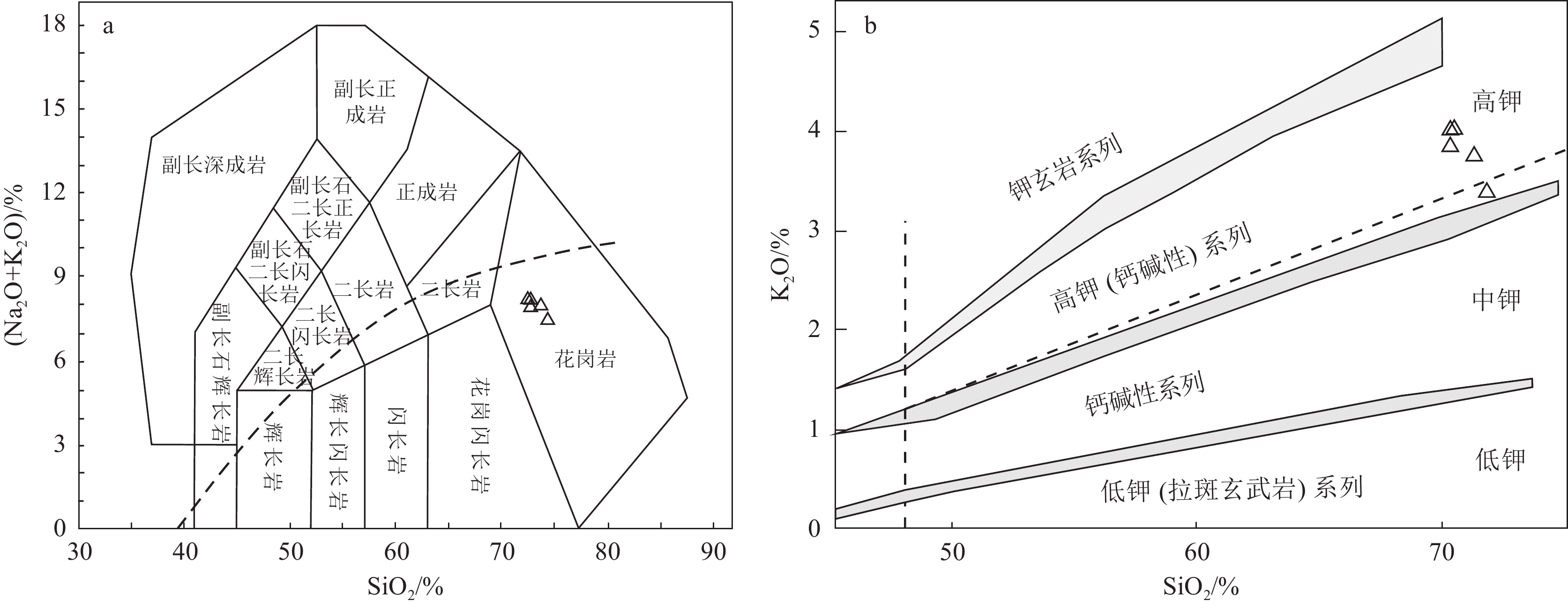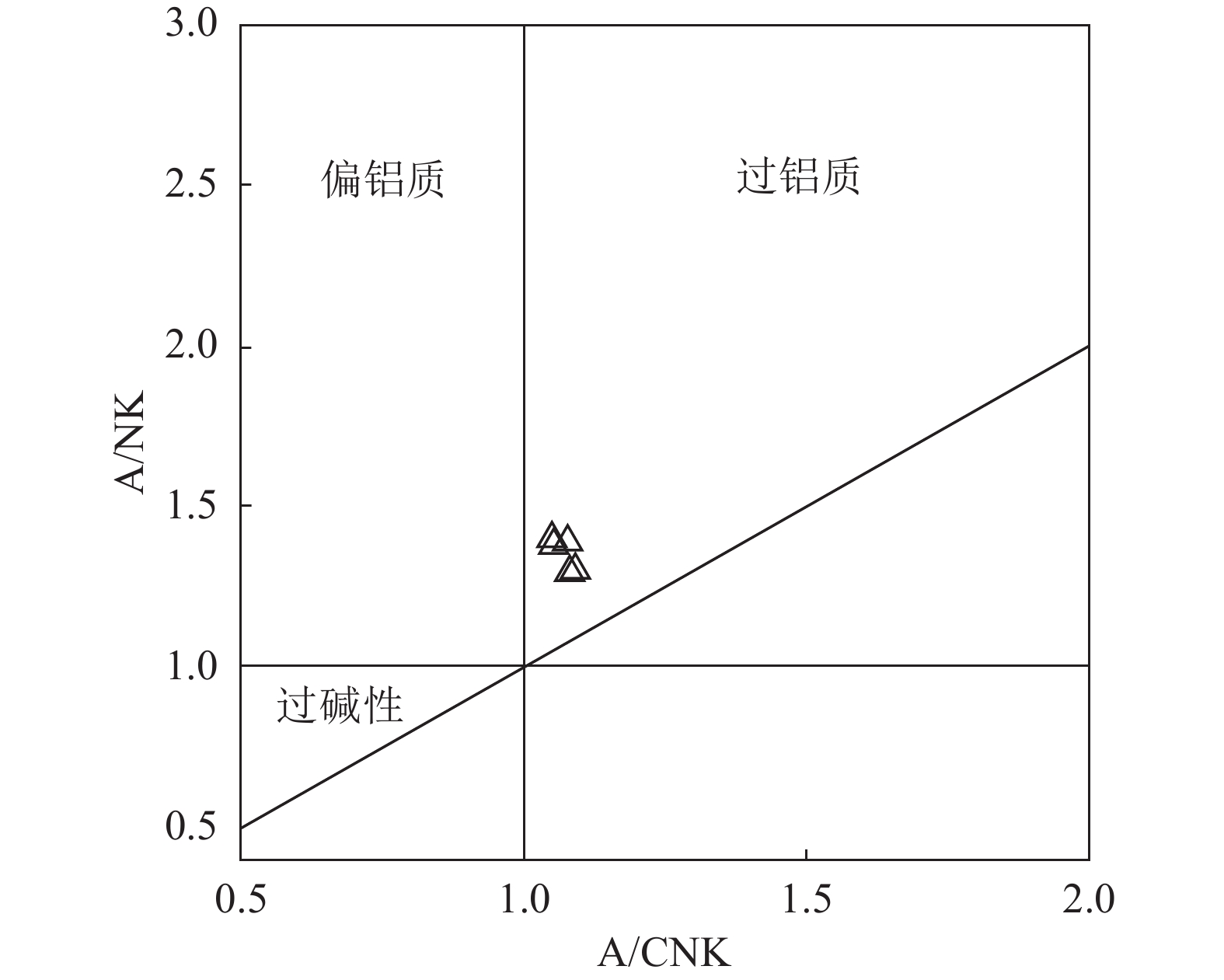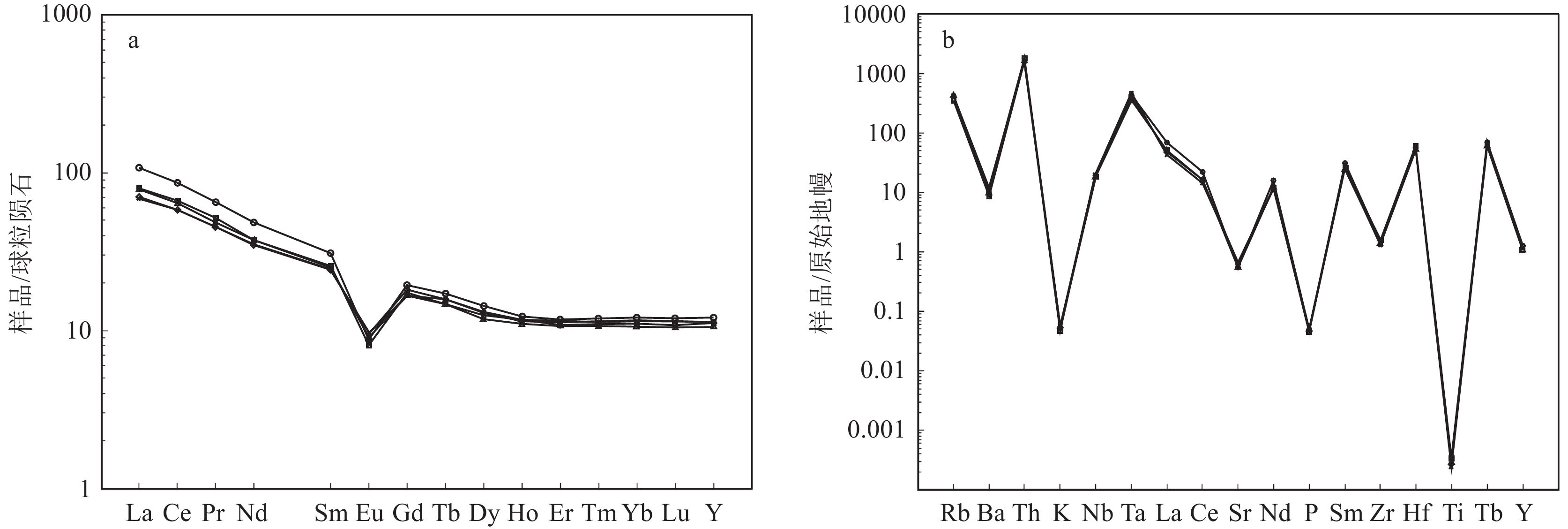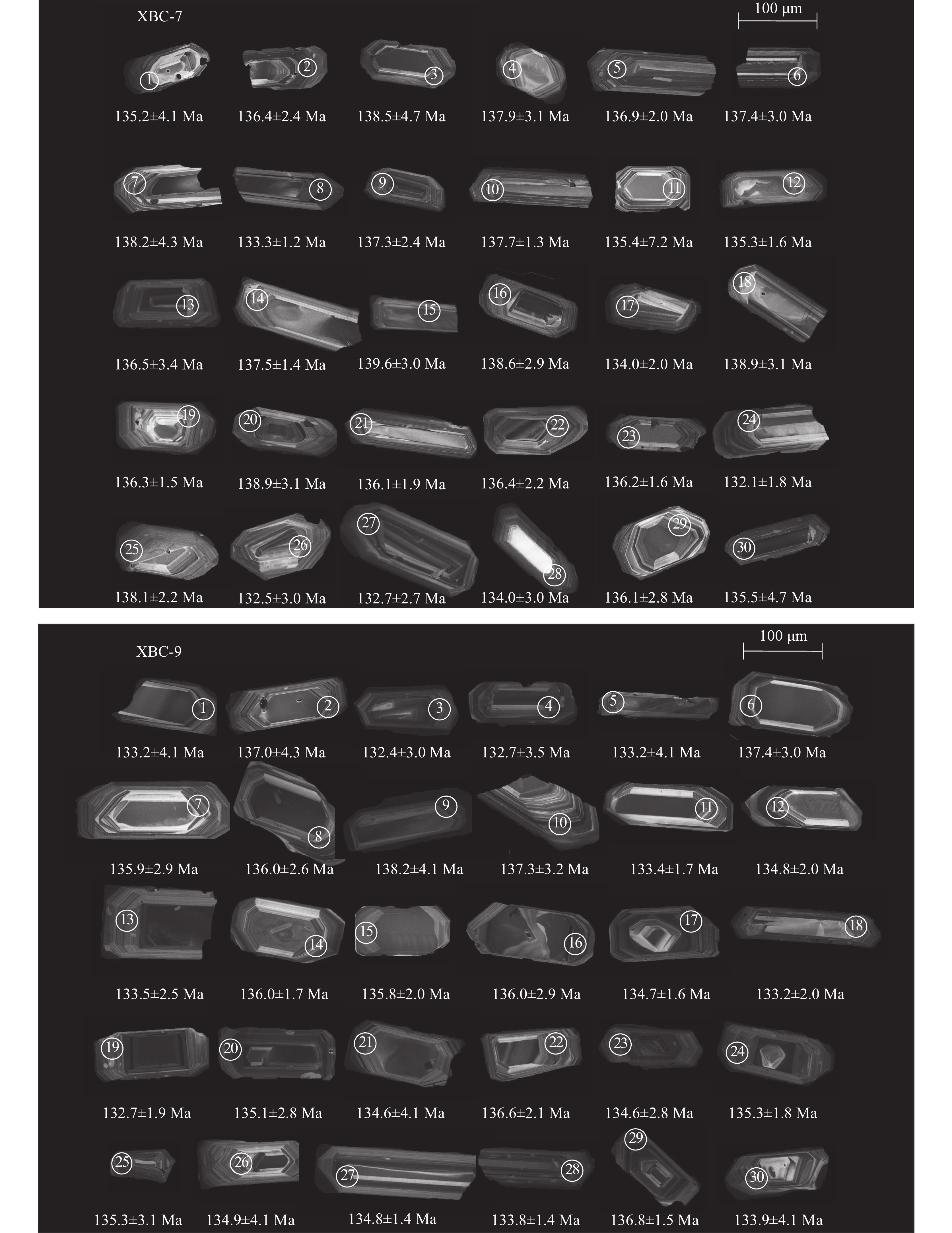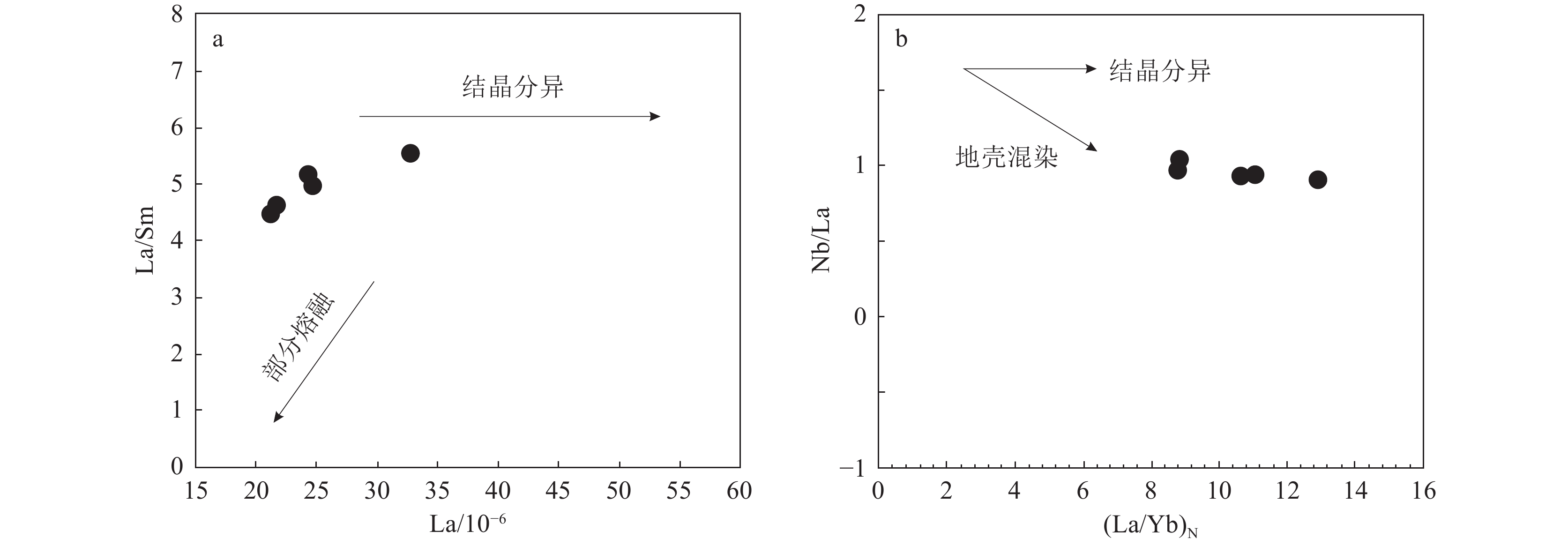Zircon U−Pb age and geochemical characteristics of biotite monzonitic granite and mineralization background in Xiaodachuan Pb−Zn−Cu deposit of Inner Mongolia, the southern Great Khingan Range
-
摘要:
研究目的 大兴安岭南段新发现的小大川铅锌铜矿赋存于黑云母二长花岗岩体中,在空间上受到燕山晚期侵入岩的影响。其成岩成矿时代、岩石成因及成矿地质背景等尚不清楚,对其研究可以为区域内铅锌成矿规律提供新的依据。
研究方法 采集大兴安岭南段小大川铅锌铜矿黑云母二长花岗岩样品,进行岩相学、锆石U−Pb测年,岩石地球化学及Sr−Nd同位素分析。
研究结果 研究表明,小大川黑云母二长花岗岩的锆石U−Pb年龄为135.9±0.8 Ma和134.9±0.8 Ma,表明铅锌矿化发生在早白垩世。岩石地球化学特征显示,黑云母二长花岗岩富SiO2(71.29%~72.92%)、K2O+Na2O(7.17%~7.89%)、Al2O3(13.35%~14.48%),贫MgO(0.61%~0.64%)、CaO(1.24%~1.73%),富集Nb、Ta、Zr、Hf、Th元素,亏损Ba、K、Sr、P、Ti元素且稀土元素配分型式呈“海鸥型”分布,δEu值为0.35~0.47,负Eu异常明显,属于高钾钙碱性、过铝质A2型花岗岩。Sr−Nd同位素特征显示(87Sr/86Sr)i值为0.70545~0.70548,εNd(t)值为−1.7~−0.3,Nd同位素的二阶段模式年龄为957~1071 Ma。
结论 结合年代学特征及地球化学特征,认为岩石成因为新生地壳和幔源物质混合同时受到上地壳混染。小大川黑云母二长花岗岩形成于蒙古-鄂霍茨克洋闭合造山后的伸展环境,该环境同时还导致了区域内成岩成矿作用的发生。
Abstract:Objective The newly discovered Xiaodachuan Pb−Zn−Cu deposit in the southern section of the Greater Khingan Range occurs in the biotite monzonitic granite body and is spatially affected by the late Yanshanian intrusive rocks. The age of diagenesis and mineralization, petrogenesis and metallogenic geological background are still unclear. The study can provide a new basis for the metallogenic regularity of lead and zinc in the area.
Methods Samples of biotite monzogranite from the Xiaodachuan Pb−Zn−Cu deposit in the southern section of the Greater Khingan Range were collected for petrographic study, zircon U−Pb dating, whole rock geochemical analysis, and Sr−Nd isotopic investigations.
Results Research shows that the zircon U−Pb ages of the biotite monzonitic granite are 135.9±0.8 Ma and 134.9±0.8 Ma, indicating that the Pb−Zn mineralization occurred in the Early Cretaceous. The rock geochemical characteristics show that the biotite monzonitic granite is rich in SiO2(71.29%~72.92%), K2O+Na2O(7.17%~7.89%), Al2O3(13.35%~14.48%), poor in MgO(0.61%~0.64%) and CaO(1.24%~1.73%), enriched in Nb, Ta, Zr, Hf and Th elements, depleted in Ba, K, Sr, P and Ti elements, and the rare earth distribution pattern is “seagull” type. The δEu value is 0.35~0.47, and the negative Eu anomaly is obvious. It belongs to high−potassium calc−alkaline and peraluminous A2−type granite. The Sr−Nd isotope characteristics show that the (87Sr/86Sr)i value is 0.70545~0.70548, the εNd(t) value is −1.7 ~ −0.3, and the two−stage model age of Nd isotope is 1071~957 Ma.
Conclusions Combined with the chronological and geochemical characteristics, it is considered that the diagenetic material is a mixture of new crust and mantle−derived material and is contaminated by the upper crust. The Xiaodachuan biotite monzonitic granite was formed in an extensional environment after the closure of the Mongolia−Okhotsk Ocean, which also led to the occurrence of diagenesis and mineralization in the region.
-

-
图 1 大兴安岭南段大地构造位置(a)和地质矿产简图(b)(据Mi et al., 2022修改)
Figure 1.
图 2 小大川铅锌铜矿床地质简图(据赤峰盛源地质勘查有限公司,2018)
Figure 2.
图 4 小大川矿区Ⅰ、Ⅱ、Ⅲ号铜矿体的0号勘查线(a)和Ⅵ号铅锌矿体的3号勘查线(b)剖面图(据赤峰盛源地质勘查有限公司,2018)
Figure 4.
图 5 小大川铅锌铜矿黑云母二长花岗岩TAS图解(a)和SiO2−K2O判别图解(b)(a图据Middlemost,1994;b图据Peccerillo and Taylor,1976)
Figure 5.
图 6 小大川铅锌铜矿黑云母二长花岗岩A/CNK−A/NK图解(据Middlemost,1985)
Figure 6.
图 7 小大川铅锌铜矿黑云母二长花岗岩球粒陨石标准化稀土元素配分曲线(a)和原始地幔标准化微量元素蛛网图(b)(标准化数据分别据Sun and McDonough,1989)
Figure 7.
图 10 小大川铅锌铜矿黑云母二长花岗岩类型判别图解(底图据Collins et al.,1982;Whalen et al.,1987;Eby,1992)
Figure 10.
图 11 小大川铅锌铜矿床黑云母二长花岗岩La−La/Sm 图解(a)和(La/Yb)N−Nb/La图解(b)(底图据Allegre and Minster,1978)
Figure 11.
图 12 小大川铅锌铜矿床黑云母二长花岗岩和邻区典型矿床与成矿有关岩浆岩(87Sr/86Sr)i−εNd(t)图解(a)和源区与熔体混染的混合计算图(b)(底图据Jahn et al.,1999,2004;Wu et al.,2000)
Figure 12.
图 13 小大川铅锌铜矿黑云母二长花岗岩SiO2−TFeO/(TFeO+MgO)(a)和(Y+Nb)−Rb(b)构造环境判别图解(底图据Pearce et al.,1984;Maniar and Piccoli et al.,1989)
Figure 13.
图 14 小大川铅锌铜矿邻区典型矿床矿石的铅同位素△β−△γ分类图解(a)和硫同位素组成图解(b)(a图据朱炳泉,1998;b图据Zhai et al.,2014)
Figure 14.
表 1 小大川铅锌铜矿黑云母二长花岗岩主量、微量和稀土元素含量
Table 1. Major, trace and rare earth elements content of biotite monzogranite in the Xiaodachuan Pb−Zn−Cu deposit
元素 XBC
5-1XBC
5-2XBC-6 XBC-7 XBC-8 元素 XBC
5-1XBC
5-2XBC-6 XBC-7 XBC-8 SiO2 71.36 71.29 72.92 72.34 71.33 Zn 62 61 120 261 301 Al2O3 14.48 14.40 13.35 13.57 13.73 Li 30.2 29.5 31.1 32.1 36.4 CaO 1.73 1.72 1.50 1.25 1.24 V 24 27 26 29 29 Fe2O3 0.73 0.76 0.60 0.54 0.44 Ni 0.6 0.6 0.6 0.6 0.6 K2O 4.01 4.00 3.36 3.73 3.83 Y 23.9 23.9 23.6 25.6 22.4 MgO 0.61 0.63 0.64 0.62 0.61 Co 3.2 3.0 3.0 3.1 3.1 MnO 0.05 0.05 0.08 0.09 0.10 Ga 22.1 21.4 20.2 19.75 20.8 Na2O 3.88 3.86 3.81 3.94 3.98 Sc 5.4 5.2 4.9 4.7 5.4 P2O5 0.09 0.09 0.09 0.09 0.10 Be 3.48 3.41 3.59 3.00 2.85 TiO2 0.29 0.29 0.29 0.31 0.30 Rb/Sr 0.55 0.56 0.48 0.72 0.70 FeO 1.60 1.58 1.73 1.82 1.99 Rb/Ba 0.28 0.28 0.33 0.33 0.35 烧失量 1.25 1.36 1.41 1.77 1.63 La 21.7 21.2 24.8 33.2 24.6 Na2O+K2O 7.89 7.86 7.17 7.67 7.81 Ce 47.2 47.4 53.7 70.5 52.5 Na2O/K2O 0.97 0.97 1.13 1.06 1.04 Pr 5.56 5.59 6.33 7.79 5.94 Mg# 32.49 33.12 33.47 32.42 31.31 Nd 21.1 21.3 22.5 29.2 22.5 σ 2.20 2.18 1.72 2.01 2.15 Sm 4.82 4.88 5.02 6.08 4.93 DI 85.07 85.04 85.57 86.71 86.29 Eu 0.67 0.72 0.60 0.65 0.67 A/NK 1.35 1.35 1.35 1.29 1.28 Gd 4.70 4.34 4.51 5.05 4.35 A/CNK 1.04 1.04 1.06 1.06 1.06 Tb 0.75 0.75 0.70 0.82 0.70 Sr 291 288 291 243 241 Dy 4.23 4.23 4.04 4.66 3.83 Rb 160 160 140 175 168 Ho 0.82 0.85 0.84 0.89 0.80 Ba 573 565 426 524 483 Er 2.42 2.42 2.32 2.49 2.26 Th 11.15 10.98 12.85 12.85 11.63 Tm 0.37 0.36 0.36 0.39 0.35 U 4.29 4.22 4.63 5.29 2.34 Yb 2.43 2.39 2.31 2.55 2.23 Cr 3.00 2.00 3.00 2.00 3.00 Lu 0.37 0.37 0.35 0.39 0.34 Ta 0.75 0.74 0.71 0.72 0.60 ΣLREE 101.1 101.1 113.0 147.4 111.1 Nb 9.80 9.70 9.30 9.50 9.30 ΣHREE 16.09 15.71 15.43 17.24 14.86 Zr 174 168 193 187 174 (La/Sm)N 2.83 2.73 3.11 3.43 3.14 Hf 5.0 4.9 5.8 5.3 5.0 (Gd/Yb)N 1.56 1.47 1.58 1.60 1.57 Cu 6.3 5.9 76.0 47.4 122.5 (La/Yb)N 6.02 5.98 7.23 8.78 7.44 Pb 20 19.8 96 155 276 δEu 0.43 0.47 0.38 0.35 0.43 注:主量元素含量单位为%,微量和稀土元素含量单位为10−6 表 2 小大川铅锌铜矿床黑云母二长花岗岩LA−ICP−MS锆石U−Th−Pb数据
Table 2. LA−ICP−MS zircon U−Th−Pb geochronological data for the biotite monzogranite from the Xiaodachuan Pb−Zn−Cu deposit
测点号 Pb/10−6 Th/10−6 U/10−6 Th/U 207Pb/206Pb 207Pb/235U 206Pb/238U 207Pb/235U 206Pb/238U 比值 1σ 比值 1σ 比值 1σ 年龄/Ma 1σ 年龄/Ma 1σ XBC-7-02 82 678 2009 0.34 0.04913 0.00295 0.1458 0.0083 0.02138 0.00037 138.2 7.4 136.4 2.4 XBC-7-03 68 720 1153 0.62 0.04856 0.00532 0.1459 0.0170 0.02172 0.00075 138.3 15.1 138.5 4.7 XBC-7-04 28 268 658 0.41 0.04924 0.00354 0.1451 0.0095 0.02162 0.00049 137.6 8.4 137.9 3.1 XBC-7-05 84 836 1752 0.48 0.04899 0.00279 0.1453 0.0081 0.02146 0.00032 137.8 7.2 136.9 2.0 XBC-7-07 74 723 1125 0.64 0.04504 0.01004 0.1466 0.0317 0.02167 0.00068 138.9 28.1 138.2 4.3 XBC-7-08 89 897 1930 0.46 0.04864 0.00183 0.1403 0.0052 0.02090 0.00019 133.3 4.6 133.3 1.2 XBC-7-09 73 629 1665 0.38 0.04875 0.00345 0.1445 0.0102 0.02153 0.00038 137.1 9.1 137.3 2.4 XBC-7-10 81 830 1666 0.50 0.04867 0.00199 0.1453 0.0059 0.02160 0.00021 137.8 5.3 137.7 1.3 XBC-7-11 35 361 707 0.51 0.04869 0.00769 0.1385 0.0176 0.02122 0.00113 131.7 15.7 135.4 7.2 XBC-7-12 52 459 1211 0.38 0.04897 0.00220 0.1429 0.0062 0.02121 0.00025 135.6 5.5 135.3 1.6 XBC-7-13 65 669 1216 0.55 0.05105 0.00668 0.1438 0.0144 0.02140 0.00054 136.4 12.8 136.5 3.4 XBC-7-14 56 525 1214 0.43 0.04840 0.00200 0.1452 0.0064 0.02156 0.00022 137.6 5.6 137.5 1.4 XBC-7-15 28 246 484 0.51 0.04905 0.00341 0.1473 0.0100 0.02189 0.00047 139.5 8.9 139.6 3.0 XBC-7-17 51 522 1240 0.42 0.04937 0.00300 0.1418 0.0081 0.02101 0.00032 134.6 7.2 134.0 2.0 XBC-7-18 42 473 742 0.64 0.04899 0.00446 0.1460 0.0131 0.02178 0.00049 138.3 11.6 138.9 3.1 XBC-7-19 80 831 1614 0.52 0.04903 0.00198 0.1435 0.0055 0.02137 0.00024 136.2 4.9 136.3 1.5 XBC-7-21 58 534 1400 0.38 0.04858 0.00246 0.1435 0.0073 0.02134 0.00030 136.1 6.5 136.1 1.9 XBC-7-22 48 469 1009 0.46 0.04904 0.00270 0.1443 0.0075 0.02139 0.00036 136.9 6.6 136.4 2.2 XBC-7-23 96 1024 1738 0.59 0.04831 0.00246 0.1428 0.0069 0.02136 0.00026 135.6 6.2 136.2 1.6 XBC-7-24 98 1062 2034 0.52 0.04870 0.00293 0.1395 0.0080 0.02071 0.00029 132.6 7.1 132.1 1.8 XBC-7-25 28 229 743 0.31 0.04778 0.00645 0.1469 0.0210 0.02165 0.00035 139.2 18.6 138.1 2.2 XBC-7-26 57 568 1142 0.50 0.04732 0.00312 0.1391 0.0095 0.02077 0.00047 132.2 8.4 132.5 3.0 XBC-7-27 59 579 1253 0.46 0.04712 0.00297 0.1400 0.0089 0.02080 0.00043 133.1 7.9 132.7 2.7 XBC-7-28 38 387 741 0.52 0.04705 0.00418 0.1424 0.0120 0.02100 0.00047 135.2 10.7 134.0 3.0 XBC-7-29 59 594 1024 0.58 0.04710 0.00306 0.1436 0.0087 0.02134 0.00045 136.2 7.7 136.1 2.8 XBC-7-30 62 489 938 0.52 0.04574 0.00571 0.1443 0.0181 0.02124 0.00075 136.9 16.0 135.5 4.7 XBC-9-01 28 251 611 0.41 0.04675 0.00503 0.1401 0.0135 0.02087 0.00064 133.1 12.1 133.2 4.1 XBC-9-02 30 276 819 0.34 0.04731 0.00598 0.1450 0.0202 0.02148 0.00068 137.5 17.9 137.0 4.3 XBC-9-03 60 514 1681 0.31 0.04924 0.00508 0.1393 0.0111 0.02075 0.00047 132.4 9.9 132.4 3.0 XBC-9-05 25 206 735 0.28 0.04717 0.00706 0.1435 0.0227 0.02154 0.00048 136.2 20.2 137.4 3.0 XBC-9-06 58 583 1236 0.47 0.04858 0.00360 0.1434 0.0102 0.02130 0.00045 136.1 9.0 135.9 2.9 XBC-9-07 32 303 641 0.47 0.04977 0.00390 0.1437 0.0101 0.02132 0.00041 136.3 9.0 136.0 2.6 XBC-9-10 54 516 1402 0.37 0.04980 0.00506 0.1409 0.0128 0.02091 0.00027 133.8 11.4 133.4 1.7 XBC-9-11 38 343 906 0.38 0.04837 0.00263 0.1418 0.0088 0.02113 0.00031 134.7 7.8 134.8 2.0 XBC-9-12 40 410 831 0.49 0.04941 0.00403 0.1405 0.0105 0.02092 0.00039 133.5 9.3 133.5 2.5 XBC-9-13 54 450 1262 0.36 0.04985 0.00274 0.1444 0.0072 0.02133 0.00027 136.9 6.4 136.0 1.7 XBC-9-14 45 471 983 0.48 0.04838 0.00337 0.1427 0.0101 0.02128 0.00032 135.4 9.0 135.8 2.0 XBC-9-15 18 147 408 0.36 0.04977 0.00432 0.1431 0.0119 0.02132 0.00045 135.8 10.6 136.0 2.9 XBC-9-16 84 896 1531 0.59 0.04869 0.00205 0.1415 0.0058 0.02112 0.00025 134.3 5.2 134.7 1.6 XBC-9-17 48 423 1151 0.37 0.04935 0.00322 0.1406 0.0086 0.02088 0.00031 133.5 7.6 133.2 2.0 XBC-9-18 50 466 1166 0.40 0.04869 0.00286 0.1390 0.0076 0.02080 0.00030 132.2 6.8 132.7 1.9 XBC-9-19 91 855 2383 0.36 0.04946 0.00412 0.1429 0.0112 0.02118 0.00044 135.6 9.9 135.1 2.8 XBC-9-21 46 411 1059 0.39 0.04828 0.00355 0.1437 0.0108 0.02142 0.00034 136.4 9.6 136.6 2.1 XBC-9-22 65 593 1252 0.47 0.04895 0.00864 0.1418 0.0232 0.02110 0.00045 134.6 20.6 134.6 2.8 XBC-9-23 73 643 1807 0.36 0.04910 0.00322 0.1429 0.0087 0.02121 0.00029 135.6 7.7 135.3 1.8 XBC-9-24 60 550 1366 0.40 0.04892 0.00330 0.1431 0.0099 0.02121 0.00049 135.8 8.8 135.3 3.1 XBC-9-26 56 536 1117 0.48 0.04871 0.00180 0.1420 0.0052 0.02114 0.00023 134.8 4.6 134.8 1.4 XBC-9-27 57 513 1574 0.33 0.04888 0.00196 0.1407 0.0054 0.02098 0.00022 133.7 4.8 133.8 1.4 XBC-9-28 83 841 1728 0.49 0.04860 0.00167 0.1442 0.0051 0.02145 0.00023 136.8 4.5 136.8 1.5 XBC-9-30 44 431 918 0.47 0.04841 0.00462 0.1400 0.0129 0.02099 0.00064 133.0 11.5 133.9 4.1 表 3 小大川铅锌铜矿黑云母二长花岗岩全岩Sr−Nd同位素分析结果
Table 3. Sr−Nd isotope analysis results of whole rock of biotite monzogranite from the Xiaodachuan Pb−Zn−Cu deposit
样号 Rb/10−6 Sr/10−6 87Rb/86Sr 87Sr/86Sr 2σ ISr(t) Sm/10−6 Nd/10−6 XBC-6 140 291 1.39311 0.708139 0.000022 0.70545 5.02 22.5 XBC-7 175 243 2.08536 0.709484 0.000022 0.70546 6.08 29.2 XBC-8 168 241 2.01856 0.709374 0.000021 0.70548 4.93 22.5 样号 147Sm/144Nd 143Nd/144Nd 2σ INd(t) εNd(t) fSm/Nd TDM/Ma T2DM/Ma XBC-6 0.13489 0.512494 0.000013 0.512374 −1.7 -0.31 1271 1071 XBC-7 0.12589 0.512558 0.000009 0.512446 −0.3 -0.36 1030 957 XBC-8 0.13247 0.512518 0.000008 0.512400 −1.2 −0.33 1188 1030 表 4 小大川铅锌铜矿及邻区典型矿床成岩成矿年龄
Table 4. Ages of diagenesis and mineralization of typical deposits in Xiaodachuan Pb−Zn−Cu deposit and its adjacent areas
矿床名称 矿床类型 矿种 围岩锆石
U−Pb年龄矿化年龄 参考文献 双尖子山 热液脉型 铅−锌−银 花岗斑岩
135.2±1.4 Ma135.0±0.6 Ma
Re-Os年龄Zhai et al.,2020
王祥东,2017白音诺尔 矽卡岩型 铅−锌−银 长石斑岩
136±2 Ma138.8±0.9 Ma
Re-Os年龄Jiang et al.,2017 小井子 热液脉型 铜−铅−锌−银 黑云母二长花岗岩
136.2±1.1 Ma早白垩世 Mi et al.,2022 姚儿吐 热液脉型 铅−锌−银 二长花岗岩
137.1±0.4 Ma早白垩世 Mi et al.,2021 白音额勒布 热液脉型 银−铅−锌 花岗斑岩
141.6±1.6 Ma144.1±2.1 Ma 宋开瑞,2019 边家大院 斑岩-热液脉型 锡−银−铅−锌−铜 花岗斑岩
140.8±0.9 Ma
140.2±0.6 Ma140.0±1.7 Ma Re-Os年龄 Ruan et al.,2015
Zhai et al.,2017小大川 热液脉型 铜−铅−锌 黑云母二长花岗岩
135.9±0.8 Ma早白垩世 本文 -
[1] Allegre C J, Minster J F. 1978. Quantitative models of trace element behavior in magmatic processes[J]. Earth and Planetary Science Letters, 38(1): 1−25.
[2] Bonin B. 2007. A−type granites and related rocks: Evolution of a concept, problems and prospects[J]. Lithos, 97(1/2): 1−29. doi: 10.1016/j.lithos.2006.12.007
[3] Chen Y J, Chen H Y, Zaw K, et al. 2007. Geodynamic settings and tectonic model of skarn gold deposits in China: an overview[J]. Ore Geology Reviews, 31(1-4): 139−169. doi: 10.1016/j.oregeorev.2005.01.001
[4] Collins W J, Beams S D, White A J R, et al. 1982. Nature and origin of A−type granites with particular reference to southeastern Australia[J]. Contributions to Mineralogy and Petrology, 80(2): 189−200.
[5] Eby G N. 1992. Chemical subdivision of the A−type granitoids; petrogenetic and tectonic implications[J]. Geology (Boulder), 20(7): 641−644. doi: 10.1130/0091-7613(1992)020<0641:CSOTAT>2.3.CO;2
[6] Frost B R, Barnes C G, Collins W J. 2001. A Geochemical classification for granitic rocks[J]. Journal of Petrology, 42(11): 2033−2048. doi: 10.1093/petrology/42.11.2033
[7] Goldfarb R J, Mao J W, Qiu K F, et al. 2021. The great Yanshanian metallogenic event of eastern Asia: Consequences from one hundred million years of plate margin geodynamics[J]. Gondwana Research, 100: 223−250. doi: 10.1016/j.gr.2021.02.020
[8] Goldstein S J, Jacobsen S B. 1988. Rare earth elements in river waters[J]. Earth and Planetary Science Letters, 89(1): 35−47. doi: 10.1016/0012-821X(88)90031-3
[9] Griffin W L, Wang X, Jackson S E, et al. 2002. Zircon chemistry and magma mixing, SE China: In−situ analysis of Hf isotopes, Tonglu and Pingtan igneous complexes[J]. Lithos, 61(3/4): 237−269.
[10] Gu Y C, Chen R Y, Jia B, et al. 2017. Zircon U−Pb dating and geochemistry of the syenogranite from the Bianjiadayuan Pb−Zn−Ag deposit of Inner Mongolia and its tectonic implications[J]. Geology in China, 44(1): 101−117 (in Chinese with English abstract).
[11] Jacobsen S B, Wasserburg G J. 1984. Sm−Nd isotopic evolution of chondrites and achondrites, II[J]. Earth and Planetary Science Letters, 67(2): 137−150. doi: 10.1016/0012-821X(84)90109-2
[12] Jahn B M, Capdevila R, Liu D Y, et al. 2004. Sources of Phanerozoic granitoids in the transect Bayanhongor−Ulaan Baatar, Mongolia: geochemical and Nd isotopic evidence, and implications for Phanerozoic crustal growth[J]. Journal of Asian Earth Sciences, 23(5): 629−653.
[13] Jahn B M, Wu F Y, Lo C H, et al. 1999. Crust−mantle interaction induced by deep subduction of the continental crust: geochemical and Sr−Nd isotopic evidence from post−collisional mafic−ultramafic intrusions of the northern Dabie complex, central China[J]. Chemical Geology, 157(1−2): 119−146.
[14] Jiang H Y, Zhao Z D, Zhu X Y, et al. 2020. Characteristics and metallogenic significance of granite porphyry and pyroxene diorite in the Bianjiadayuan Pb−Zn−Ag polymetallic deposit, Inner Mongolia[J]. Geology in China, 47(2): 450−471 (in Chinese with English abstract).
[15] Jiang S H, Chen C L, Bagas L, et al. 2017. Two mineralization events in the Baiyinnuoer Zn−Pb deposit in Inner Mongolia, China: Evidence from field observations, S−Pb isotopic compositions and U−Pb zircon ages[J]. Journal of Asian Earth Sciences, 144: 339−367.
[16] King P L, White A J R, Chappell B W, et al. 1997. Characterization and Origin of Aluminous A−type Granites from the Lachlan Fold Belt, Southeastern Australia[J]. Journal of Petrology, 38(3): 371−391.
[17] Koschek, G. 1993. Origin and significance of the SEM cathodoluminescence from zircon[J]. Microsc, 171(3): 223−232. doi: 10.1111/j.1365-2818.1993.tb03379.x
[18] Li J Y. 2006. Permian geodynamic setting of Northeast China and adjacent regions: closure of the Paleo−Asian Ocean and subduction of the Paleo−Pacific Plate[J]. Journal of Asian Earth Sciences, 26(3/4): 207−224. doi: 10.1016/j.jseaes.2005.09.001
[19] Liu J M, Zhang R, Zhang Q Z. 2004. The regional metallogeny of da hinggan ling, China[J]. Geoscience Frontiers, 11(1): 269−277 (in Chinese with English abstract).
[20] Liu L J, Zhou T F, Zhang D Y, et al. 2018. S isotopic geochemistry, zircon and cassiterite U−Pb geochronology of the Haobugao Sn polymetallic deposit, southern Great Xing’an Range, NE China[J]. Ore Geology Reviews, 93: 168−180.
[21] Liu Y J, Li W M, Feng Z Q, et al. 2017. A review of the Paleozoic tectonics in the eastern part of Central Asian Orogenic Belt[J]. Gondwana Research, 43: 123−148.
[22] Liu Y S, Hu Z C, Zong K Q, et al. 2010. Reappraisement and refinement of zircon U−Pb isotope and trace element analyses by LA−ICP−MS[J]. Chinese Science Bulletin, 55(15): 1535−1546. doi: 10.1007/s11434-010-3052-4
[23] Ludwig K R. 2003. User’s Manual for Isoplot 3.00: A Geochronological Toolkit for Microsoft Excel[M]. Berkeley: Berkeley Geochronology Center Special Publication, 4.
[24] Lv Z C, Duan G Z, Liu C Q, et al. 2000. Types of Silver Deposits, Metallogenic Series, and Metallogenic Geochemical Characteristics in the Greater Khingan Mountains Region[J]. Bulletin of Mineralogy, Petrology and Geochemistry, 19(4): 305−309 (in Chinese with English abstract).
[25] Maniar P D, Piccoli P M. 1989. Tectonic discrimination of granitoids[J]. Geological Society of America Bulletin, 101(5): 635−643. doi: 10.1130/0016-7606(1989)101<0635:TDOG>2.3.CO;2
[26] Mao J W, Zhou Z H, Wu G, et al. 2013. Metallogenic regularity and minerogenetic series of ore deposits in Inner Mongolia and adjacent areas[J]. Mineral Deposits, 32(4): 715−729 (in Chinese with English abstract).
[27] McDonough W F, Sun S S, Ringwood A E, et al. 1992. Potassium, rubidium, and cesium in the Earth and Moon and the evolution of the mantle of the Earth[J]. Geochimica et Cosmochimica Acta, 56(3): 1001−1012. doi: 10.1016/0016-7037(92)90043-I
[28] Metelkin D V, Vernikovsky V A, Kazansky A Y. 2010. Late Mesozoic tectonics of Central Asia based on paleomagnetic evidence[J]. Gondwana Research, 18(2/3): 400−419.
[29] Mi K F, Lu Z C, Li C F, et al. 2017. Origin of the Badaguan porphyry Cu−Mo deposit, Inner Mongolia, northeast China: Constraints from geology, isotope geochemistry and geochronology[J]. Ore Geology Reviews, 81(1): 154−172. doi: 10.1016/j.oregeorev.2016.09.029
[30] Mi K F, Lu Z C, Liu Q, et al. 2021. Zircon U−Pb ages and geochemical characteristics of granites in the Yaoertu deposit: Implications for Pb−Zn−Ag mineralization in the southern Great Xing’an Range, NE China[J]. Ore Geology Reviews, 220: 106666. doi: 10.1016/j.oregeorev.2021.104160
[31] Mi K F, Lu Z C, Yan T J, et al. 2020. Zircon geochronological and geochemical study of the Baogaigou Tin deposits, southern Great Xing'an Range, Northeast China: Implications for the timing of mineralization and ore genesis[J]. Geological Journal, 55(7): 5062−5081. doi: 10.1002/gj.3729
[32] Mi K F, Lü Z C, Zhao S J, et al. 2021. Petrogenesis and metallogenic implications of the Late Jurassic Dagayin pluton, southern Great Xing'an Range, northeast China: Integrated geochronological, petrological, and geochemical constraints[J]. Journal of Geochemical Exploration, (220): 106666.
[33] Mi, K F, Lü Z C, Yan, T J, et al. 2022. Zircon U−Pb geochronology and Sr−Nd−Hf−O isotopic constraints on the relationship between Mo and Pb−Zn mineralization in the Haisugou pluton in the southern Great Xing'an Range, northeast China[J]. Ore Geology Reviews, 144: 104838. doi: 10.1016/j.oregeorev.2022.104838
[34] Middlemost E A, Magmas K, Rocks M. 1985. An introduction to igneous petrology[J]. Magma and magmatic Rocks, Longmans.
[35] Middlemost E A. 1994. Naming materials in the magma/igneous rock system[J]. Earth−Science Reviews, 37(3/4): 215−224.
[36] Ouyang H G, Mao J W, Zhou Z H. 2015. Late Mesozoic metallogeny and intracontinental magmatism, southern Great Xing'an Range, northeastern China[J]. Gondwana Research, 27(3): 1153−1172.
[37] Pearce J A, Harris N B W, Tindle A G. 1984. Trace element discrimination diagrams for the tectonic interpretation of granitic rocks[J]. Journal of Petrology, 25(4): 956−983. doi: 10.1093/petrology/25.4.956
[38] Peccerillo A, Taylor S R. 1976. Geochemistry of eocene calc−alkaline volcanic rocks from the Kastamonu area, Northern Turkey[J]. Contributions to Mineralogy and Petrology, 58(1): 63−81. doi: 10.1007/BF00384745
[39] Pei Q M, Zhang S T, Santosh M, et al. 2017. Geochronology, geochemistry, fluid inclusion and C, O and Hf isotope compositions of the Shuitou fluorite deposit, Inner Mongolia, China[J]. Ore Geology Reviews, 83: 174−190.
[40] Rapp R P, Shimizu N, Norman M D, et al. 1999. Reaction between slab−derived melts and peridotite in the mantle wedge: experimental constraints at 3.8 GPa[J]. Chemical Geology, 160(4): 335−356. doi: 10.1016/S0009-2541(99)00106-0
[41] Ren W K, Wang S Y, Chen L B, et al. 2020. LA−ICP−MS zicon U−Pb geochronology, geochemistry and geological significance of granodiorites in Lancai Area, Tongren, Qinghai[J]. Journal of Jilin University: Earth Science Edition, 50(4): 1059−1074 (in Chinese with English abstract).
[42] Ruan B X, Lv X B, Yang W, et al. 2015. Geology geochemistry and fluid inclusions of the Bianjiadayuan Pb−Zn−Ag deposit, Inner Mongolia, NE China: Implications for tectonic setting and metallogeny(Article)[J]. Ore Geology Reviews, 71: 121−137. doi: 10.1016/j.oregeorev.2015.05.004
[43] Rudnick R L, Gao S, Holland H D, et al. 2003. Composition of the continental crust[J]. The Crust, 3: 1−64.
[44] Shellnutt J S, Jahn B M. 2010. Formation of the Late Permian Panzhihua plutonic−hypabyssal−volcanic igneous complex: Implications for the genesis of Fe−Ti oxide deposits and A−type granites of SW China[J]. Earth and Planetary Science Letters, 289(3/4): 509−519.
[45] Sheng J F, Fu X Z, et al. 1999. Metallogenic Environment and geological characteristics of copper−polymetallic deposits in the central section of the Greater Khingan Mountains[M]. Beijing: Seismological Press: 1− 216 (in Chinese with English abstract).
[46] Song K R. 2019. The Metallogenic Relationship between fluorite deposits and silver−polymetallic deposits and its prospecting significance in the Linxi Area of Inner Mongolia[D]. Doctoral Dissertation of China University of Geosciences (Beijing) (in Chinese with English abstract).
[47] Sun S S, McDonough W F. 1989. Chemical and isotopic systematics of oceanic basalts: implications for mantle composition and processes[J]. Geological Society, London, Special Publications, 42(1): 313−345.
[48] Taylor S. R, McLennan S M. 1985. The continental crust: Its composition and evolution[M]. Blackwell Scientific Pub.: 1−312.
[49] Wang F X, Bagas L, Jiang S H, et al. 2017. Geological, geochemical, and geochronological characteristics of Weilasituo Sn−polymetal deposit, Inner Mongolia, China[J]. Ore Geology Reviews, 80: 1206−1229. doi: 10.1016/j.oregeorev.2016.09.021
[50] Wang H, Li F, Zhang G H. 2019. Genesis and prospecting indicators of the Xiaodachuan lead−zinc−copper polymetallic deposit in Inner Mongolia[J]. Inner Mongolia Science Technology and Economy, (6): 66 (in Chinese with English abstract).
[51] Wang J B, Wang Y W, Wang L J, et al. 2001. Tin−polymetallic mineralization in the southern part of the Da Hinggan Mountains, China[J]. Resource Geology, 51(4): 283−291.
[52] Wang X D, Xu D M, Lv X B, et al. 2018. Origin of the Haobugao skarn Fe−Zn polymetallic deposit, Southern Great Xing'an Range, NE China: geochronological, geochemical, and Sr−Nd−Pb isotopic constraints[J]. Ore Geology Reviews, 94: 58−72.
[53] Wang X D. 2017. Diagenesis and Metallogenesis of the Silver−Lead−Zinc Polymetallic Deposit in the Lindong Area, Inner Mongolia[D]. Doctoral Dissertation of China University of Geosciences (Beijing) (in Chinese with English abstract).
[54] Wang T, Guo L, Zhang L, et al. 2015. Timing and evolution of Jurassic-Cretaceous granitoid magmatisms in the Mongol−Okhotsk Belt and adjacent areas, NE Asia: Implications for transition from contractional crustal thickening to extensional thinning and geodynamic Settings[J]. Journal of Asian Earth Sciences, 97(1): 365−392.
[55] Whalen J B, Currie K L, Chappell B W. 1987. A−type granites: geochemical characteristics, discrimination and petrogenesis[J]. Contributions to Mineralogy and Petrology, 95(4): 407−419.
[56] Wickham S M, Alberts A D, Zanvillevich A N, et al. 1996. A stable isotope study of anorogenic magmatism in East Central Asia[J]. Journal of Petrology, 37(5): 1063−1095. doi: 10.1093/petrology/37.5.1063
[57] Wu F Y, Jahn B M, Wilde S A, et al. 2003. Highly fractionated I−type granites in NE China (II): Isotopic geochemistry and implications for crustal growth in the Phanerozoic[J]. Lithos, 64(3/4): 191−204.
[58] Wu F Y, Jahn B M, Wilde S W, et al. 2000. Phanerozoic crustal growth: U−Pb and Sr−Nd isotopic evidence from the granites in northeastern China[J]. Tectonophysics, (1/2): 89−113.
[59] Wu F Y, Sun D Y, Li H M, et al. 2002. A−type granites in northeastern China: Age and geochemical constraints on their petrogenesis[J]. Chemical Geology, 187(1/2): 143−173.
[60] Yang J H, Wu F Y, Chung S L, et al. 2007. A hybrid origin for the Qianshan A−type granite, northeast China: geochemical and Sr−Nd−Hf isotopic evidence[J]. Lithos, 89(1/2): 89−106.
[61] Yao L, Lv Z C, Ye T Z, et al. 2017. Zircon U−Pb age, geochemical and Nd−Hf isotopic characteristics of quartz porphyry in the Baiyinchagan Sn polymetallic deposit, Inner Mongolia, southern Great Xing'an Range, China[J]. Acta Petrologica Sinica, 33(10): 3183−3199 (in Chinese with English abstract).
[62] Zhai D G, Liu J J, Wang J P, et al. 2014. Zircon U−Pb and molybdenite Re−Os geochronology, and whole−rock geochemistry of the Hashitu molybdenum deposit and host granitoids, Inner Mongolia, NE China[J]. Journal of Asian Earth Sciences, 79(1): 144−160. doi: 10.1016/j.jseaes.2013.09.008
[63] Zhai D G, Liu J J, Zhang A L, et al. 2017. U−Pb, Re−Os, and 40Ar/39Ar geochronology of porphyry Sn±Cu±Mo and polymetallic (Ag−Pb−Zn−Cu) vein mineralization at Bianjiadayuan, Inner Mongolia, NE China: Implications for discrete mineralization events[J]. Economic Geology, (8): 2041−2059.
[64] Zhai D G, Williams−Jones A E, Liu J J, et al. 2020. The genesis of the giant Shuangjianzishan epithermal Ag−Pb−Zn deposit, Inner Mongolia, northeastern China[J]. Economic Geology, 115(1): 101−128.
[65] Zhang L L, Jiang S H, Bagas L, et al. 2019. Element behaviour during interaction of magma and fluid: A case study of Chamuhan Granite, implications on the genesis of W−Mo mineralisation[J]. Lithos, 342: 31−44.
[66] Zhang W, Lentz D R, Thorne K G, et al. 2020. Late Silurian−Early Devonian slab break−off beneath the Canadian Appalachians: Insights from the Nashwaak Granite, west−central New Brunswick, Canada[J]. Lithos, 358: 105393.
[67] Zhao G L, Yang G L, Fu J Y. 1989. Mesozoic volcanic rocks in the central and southern parts of the Greater Khingan Mountains[M]. Beijing: Beijing Science and Technology Press: 1−252 (in Chinese).
[68] Zhao J Q, Zhou Z H, Ouyang H G, et al. 2022. Zircon U−Pb age and geochemistry of quartz syenite porphyry in Shuangjianzishan Ag−Pb−Zn(Sn) deposit, Inner Mongolia, and their geological implications[J]. Mineral Deposits, 41(2): 324−344 (in Chinese with English abstract).
[69] Zhao Y M, Wang D W, Zhang D Q, et al. 1994. Geological conditions for copper−polymetallic metallogenesis and prospecting models in the southeastern part of Inner Mongolia[M]. Beijing: Seismological Press: 1− 234 (in Chinese with English abstract).
[70] Zhou Z H, Mao J W, Lyckberg P. 2012. Geochronology and isotopic geochemistry of the A−type granites from the Huanggang Sn−Fe deposit, southern Great Hinggan Range, NE China: Implication for their origin and tectonic setting[J]. Journal of Asian Earth Sciences, 48: 272−286.
[71] Zhu B Q. 1998. Study on chemical heterogeneities of mantle crustal systems and geochemical boundaries of blocks[J]. Earth Science Frontiers, 5(1): 72−82 (in Chinese with English abstract).
[72] Zorin Y A. 1999. Geodynamics of the western part of the Mongolia−Okhotsk collisional belt, Trans−Baikal region (Russia) and Mongolia[J]. Tectonophysics, 306(1): 33−56.
[73] 赤峰盛源地质勘查有限公司. 2018. 内蒙古自治区巴林右旗小大川矿区铅锌铜矿详查报告[R].
[74] 顾玉超, 陈仁义, 贾斌, 等. 2017. 内蒙古边家大院铅锌银矿床深部正长花岗岩年代学与形成环境研究[J]. 中国地质, 44(1): 101−117. doi: 10.12029/gc20170108
[75] 蒋昊原, 赵志丹, 祝新友, 等. 2020. 内蒙古边家大院铅锌银矿床花岗斑岩及辉石闪长岩特征及对成矿的指示[J]. 中国地质, 47(2): 450−471. doi: 10.12029/gc20200213
[76] 刘建明, 张锐, 张庆洲. 2004. 大兴安岭地区的区域成矿特征[J]. 地学前缘, 11(1): 269−277. doi: 10.3321/j.issn:1005-2321.2004.01.024
[77] 吕志成, 段国正, 刘丛强, 等. 2000. 大兴安岭地区银矿床类型、成矿系列及成矿地球化学特征[J]. 矿物岩石地球化学通报, 19(4): 305−309. doi: 10.3969/j.issn.1007-2802.2000.04.037
[78] 毛景文, 周振华, 武广, 等. 2013. 内蒙古及邻区矿床成矿规律与成矿系列[J]. 矿床地质, 32(4): 715−729. doi: 10.3969/j.issn.0258-7106.2013.04.006
[79] 任纪舜, 陈廷愚, 牛宝贵, 等. 1992. 中国东部及邻区大陆岩石圈的构造演化与成矿[M]. 北京: 科学出版社: 90−103.
[80] 任文恺, 王生云, 陈礼标, 等. 2020. 青海同仁兰采地区花岗闪长岩LA−ICP−MS锆石U−Pb年代学、地球化学特征及其地质意义[J]. 吉林大学学报(地球科学版), 50(4): 1059−1074.
[81] 盛继福, 傅先政, 等. 1999. 大兴安岭中段成矿环境与铜多金属矿床地质特征[M]. 北京: 地震出版社: 1− 216.
[82] 宋开瑞. 2019. 内蒙古林西地区萤石矿与银多金属矿成矿关系及找矿意义[D]. 中国地质大学(北京)博士学位论文.
[83] 王河, 李峰, 张国辉. 2019. 内蒙古小大川铅锌铜多金属矿矿床成因与找矿标志[J]. 内蒙古科技与经济, (6): 66.
[84] 王祥东. 2017. 内蒙古林东地区银铅锌多金属矿床成岩成矿作用[D]. 中国地质大学(北京)博士学位论文.
[85] 姚磊, 吕志成, 叶天竺, 等. 2017. 大兴安岭南段内蒙古白音查干Sn多金属矿床石英斑岩的锆石U−Pb年龄、地球化学和Nd−Hf同位素特征及地质意义[J]. 岩石学报, 33(10): 3183−3199.
[86] 赵国龙, 杨桂林, 傅嘉有. 1989. 大兴安岭中南部中生代火山岩[M]. 北京: 北京科学技术出版社: 1−252.
[87] 赵家齐, 周振华, 欧阳荷根, 等. 2022. 内蒙古双尖子山银铅锌(锡)矿床石英正长斑岩U−Pb年龄地球化学及其地质意义[J]. 矿床地质, 41(2): 324−344.
[88] 赵一鸣, 王大畏, 张德全, 等. 1994. 内蒙古东南部铜多金属成矿地质条件及找矿模式[M]. 北京: 地震出版社: 1−234.
[89] 朱炳泉. 1998. 壳幔化学不均一性与块体地球化学边界研究[J]. 地学前缘, 5(1): 72−82. doi: 10.3321/j.issn:1005-2321.1998.01.008
-




 下载:
下载:

